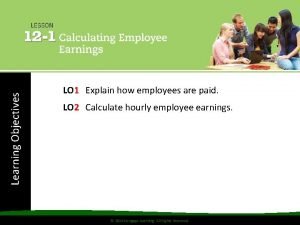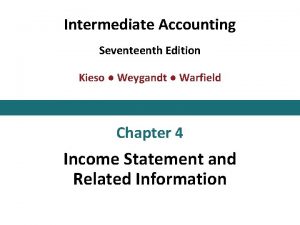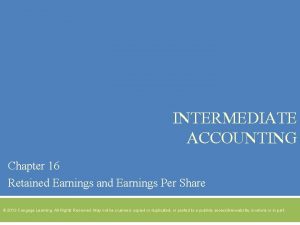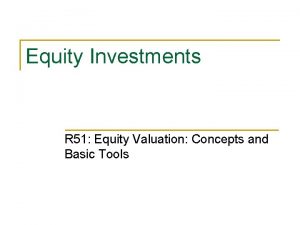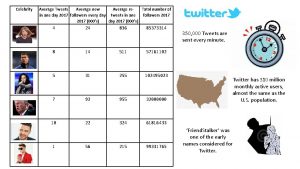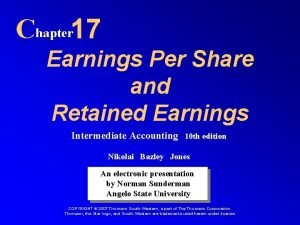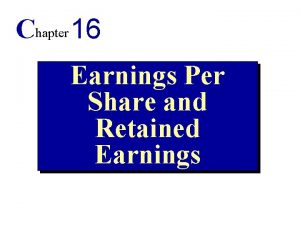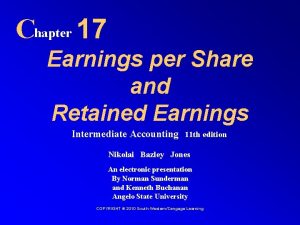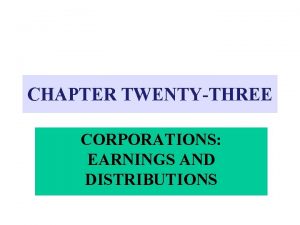Measuring Average Weekly Earnings Average weekly ordinary time
















- Slides: 16


Measuring Average Weekly Earnings : • Average weekly ordinary time earnings for full-time adults – this measures the average weekly gross rate pay (I. e. pay before tax) received by all full-time adult workers for their ‘ordinary’ working time. This does not include payment for any overtime work. • Average total earnings for full-time adults – this measures the average weekly gross rate of pay received by all full-time adult workers, including any payment for overtime work • Average total earnings for all employees – this measures the average weekly gross rate of pay to all employees, both in full-time and part-time employment, including any payment for overtime

Occupation Group Average Income $ Managers and administrators 1098 Professionals 920 Associate paraprofessionals 765 Advanced clerical, sales and service workers 606 Intermediate production and transport workers 642 Tradespersons 641 Elementary clerical, sales and service workers 523 Labourers and related workers 516 Average 716

Comparative Percentile Bands of income by age, 1999 - 00 Age Group Mean Weekly Income $ 15 -24 25 -34 25 -44 45 -54 55 -64 406 794 937 1029 725 65+ 397

Year Male Female 1987 -88 471 310 1996 -97 682 452 1988 -89 506 331 1997 -98 708 466 1989 -90 542 353 1998 -99 725 478 1990 -91 574 377 1999 -00 744 490 1991 -92 590 394 2000 -01 777 520 1992 -93 605 402 1993 -94 522 415 1994 -95 645 427 1995 -96 664 435

Birth place or Period 0 ethnic background -4 Of 5 -9 Residency (years) Average 10 -14 15+ Income $ Australia N/a N/a 28, 810 Overseas 27, 890 27, 190 30, 140 29, 600 29, 230 Average 28, 890 Overseas background English speaking 29, 050 29, 980 32, 560 32, 120 31, 660 Non-English speaking 26, 980 25, 460 27, 830 27, 660 27, 350 Africa 29, 730 26, 970 33, 610 32, 260 30, 590 America 34, 800 26, 940 30, 980 32, 260 31, 780 Asia 28, 170 24, 460 17, 050 29, 280 27, 590 Europe 27, 780 29, 140 33, 330 29, 050 29, 290

Question one – What does the main labour outcomes involve? a) Wages b) Non-wage benefits c) Employment outcomes d) All of the above

Question two – What provides the highest percentage of household incomes for Australians? a) Wages and salaries b) Government pensions or allowances c) Private income d) Operating a business

Question three – What does the Wage Cost Index measure? a) Changes in wage and employee jobs b) Changes in salary costs for employee jobs c) Changes in wage and salary cost for employee jobs d) Changes in the quality and quantity of work performed

Question four – Which of the following does not include payment for overtime work? a) Average weekly ordinary time earnings for full-time adults b) Average total earnings for full-time adults c) Average total earnings for all employees d) All of the above

Question five – What are real wages? a) A measure of the average weekly gross rate of pay that a full-time employee receives, including overtime b) A measure of the actual purchasing power of money wages c) A measure of change in wage and salary costs for employee jobs d) A measure of the average weekly gross rate of pay that a full-time employee receives, excluding overtime

Question six – In the labour market, people are generally rewarded for working in which occupations? a) Those which require a higher level of skill and a longer period of training b) Those which require a higher level of skill and a shorter period of training c) Those which require a lower level of skill and a longer period of training d) Those which require a lower level of skill and a shorter period of training

Question seven – What will influence wage rates? a) Occupational mobility b) Geographical labour mobility c) Productivity of labour d) All of the above

Question eight – In what age bracket does income tend to be the highest? a) 15 – 24 b) 25 – 34 c) 45 – 54 d) 55 - 64

Question nine – What is the major reason that women are paid less than men for the same job? a) Men like to feel superior to women and, seeing as most employers are men, most women are paid less b) Female labour is under evaluated c) There isn’t any – females are paid the same as males d) Women like to be paid less than men

Question ten – Migrants from which area earn most income within Australia? a) Asia b) Europe c) Africa d) America
 How to find principal formula
How to find principal formula Temporary adjustment of theodolite
Temporary adjustment of theodolite Temporary adjustment of theodolite
Temporary adjustment of theodolite Reiteration method in surveying
Reiteration method in surveying Reiteration method of measuring horizontal angle
Reiteration method of measuring horizontal angle When does easter end
When does easter end Ordinary time facts
Ordinary time facts Start time, end time and elapsed time
Start time, end time and elapsed time Motion in a straight line formula
Motion in a straight line formula Advantage of retained profit
Advantage of retained profit Justified trailing p/e
Justified trailing p/e How does threegreen calculate overtime earnings?
How does threegreen calculate overtime earnings? Income statement discontinued operations
Income statement discontinued operations Intermediate accounting chapter 16
Intermediate accounting chapter 16 Fundamental accounting equation
Fundamental accounting equation Justified price to earnings
Justified price to earnings Diluted earnings per share
Diluted earnings per share











